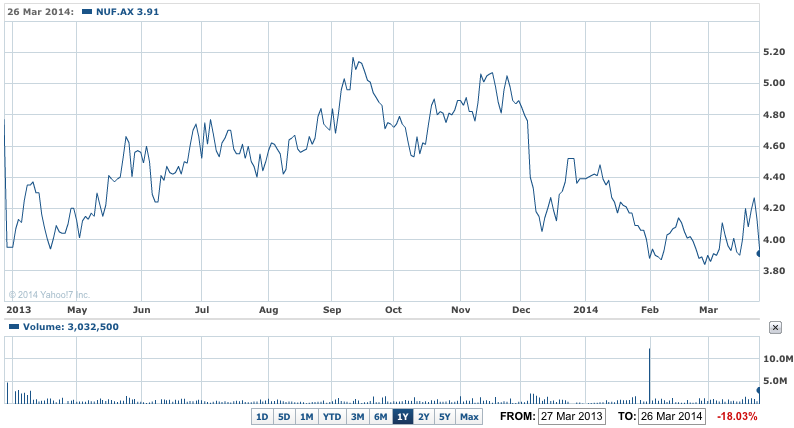Shares in Nufarm (NUF) swung sharply yesterday as investors assessed the company’s solid interim report, and speculated on the damage the recent rise in the Australian dollar would do to the company which saw sales in Brazil jump sharply in the six months to the end of January.
The shares jumped to a high of $4.30 at the opening, then fell sharply to a day’s low of $3, before recovering to end down more than 5% at $3.90.
The shares had opened 15c high, but then lost ground for the rest of the day to close off 23c – as the dollar rose.
It was a big trading range of 38c and the shares fell well under $4 in the afternoon after RBA Governor Glenn Stevens buoyed the dollar with an upbeat speech on the economy in Hong Kong.
The rise in the dollar to over 91.84 USc, a new three month high in trading in Asia yesterday, means the currency has appreciated notably from the 87 – 88 USc level it was at the end of January, when Nufarm ruled off its interim report.
The currency topped 92 US cents offshore overnight, a move that will put further pressure on the Nufarm share price today
The currency is up around 5% since then against the greenback and if that’s sustained, will cut some of the sales growth coming from places like Brazil, as the company explained in yesterday’s statement.
"Net foreign exchange losses relating to financing activities were materially lower than in the first half of the previous year ($3.5 million v $9.2 million). However, since 31 January, significant currency weakness in a number of developing markets – where hedging is not possible – has resulted in a further unrealised foreign exchange loss of some $5 million.
"Future movements in those currencies will determine the extent to which any of this is reversed by year end," Nufarm directors said.
NUF 1Y – Nufarm shares sold off on high dollar, despite profit rise

Eight days after revealing the sweeping restructure of its Australian operations (including closure of manufacturing facilities, site offices and more than 100 staff cuts), Nufarm yesterday revealed a sharp rise in net and underlying profit off the back of a 22% jump in sales to $1.138 billion.
Directors said in the ASX announcement that the statutory net profit after tax (NPAT) was $18.8 million, more than double the $8.4 million earned in the first half of 2012-13.
The company reported 20% rise in underlying earnings before interest and tax (EBIT) of $56.7 million, compared to $47.3 million in the previous corresponding half year.
According to CEO Doug Rathbone it was strong sales growth in South America, especially Brazil, that drove the rebound in sales and earnings.
"South America’s largest market, Brazil, experienced average climatic conditions for most of the period and Nufarm generated very strong revenue and earnings growth.
"This contrasted with the performance of the Australian business which was again impacted by hot and dry seasonal conditions in the major summer cropping regions of Queensland and northern NSW," Mr Rathbone said in yesterday’s statement.
That “more than offset” the impact of continuing drought conditions in Australia, and lower first half earnings from both North America and Europe, he added.
"It is anticipated that business conditions in Australia will remain challenged,” Mr Rathbone said yesterday. “While much-needed rainfall would drive increased applications of product, channel inventories are estimated to be high and pricing pressure is expected to continue for the balance of the year.” In other words retailers and distributors have a lot of unsold stock of Nufarm products which will force prices lower and keep them low while the drought-like conditions persist.
Bureau of Meteorology forecasts this week that the chances of an El Nino (drought) event in Eastern Australia are rising for later this year, won’t be happy news for Nufarm.
Rather than a weak result, which some analysts speculated after last week’s restructuring announcement, Nufarm seems to be battening down the hatches in Australia ahead of a possible intensification in the dry conditions, while rapidly expanding sales in other markets, such as Brazil.
Nufarm said its crop protection business generated an increase of 21% in sales year-on-year and accounted for 95% of group revenues (or $1.08billion). Seed technologies – the smaller part of the business – showed a healthy increase of 35% on the previous period, with first-half sales of $54 million.
A look at the Australian and New Zealand businesses helps tell the story. They generated $249 million in segment sales, up slightly on the $236 million recorded in the first half of 2013. This was 23% of total crop protection revenues in the first half period. Underlying earnings before interest and tax (EBIT) was $8.9 million, down from the $10.3 million in the prior period.
But South America with crop protection sales increased by 52% to $413 million (from $272 million in the corresponding half year) and accounted for 38% of total first half crop protection revenues. Underlying EBIT was $60 million, almost double the $34.9 million in the previous period. Nufarm said its sales in Brazil were up by more than 66% on a local currency basis.
On March 18 the company announced a “reorganisation” in Australia which will include the phased closure of two manufacturing facilities in Welshpool (Western Australia) and Lytton (Queensland), closure of six sites in the regional service centre and warehouse network, and a restructure of management, support and administration roles resulting in a "headcount reduction" across most functions of the business. Around 109 jobs will be lost, with further changes to come in NZ in the next few weeks. The company aims to save around $13 million a year in lower costs.
The company declared a full-franked dividend of 3c a share, unchanged from the previous corresponding period.













